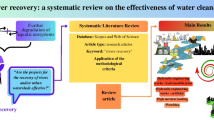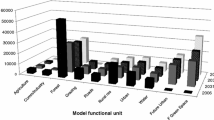Abstract
Although the area of urban river sediment quality has received increasing attention over the last 10 years, the presence of contaminated sediments in urban rivers and the potential risk to public health it poses has yet to be rigorously addressed within the urban river restoration context. This is an issue of particular concern at the current time, as the opening-up of urban rivers is being strongly promoted by many legislative and non-legislative bodies as a multi-benefit approach to tackling a range of urban challenges; from decreasing the risk of flooding to increasing the quality-of-life in urbanised areas. This paper brings together these two contrasting concepts; urban rivers as pollutant sinks and sources (presentation of data on urban river sediment quality) and urban rivers as sites of flood alleviation, amenity, recreation and wildlife value (review of the drivers and initiatives behind the increasing implementation of urban river rehabilitation schemes). In light of this combined assessment, the urgent need for a risk assessment of restored urban river sites to establish whether the presence of contaminated sediments poses a risk to public health is strongly recommended. Should such a risk be demonstrated, a tiered approach to supporting the identification and pro-active management of these risks is proposed as a way to inform and enable, rather than to prevent, the safe and appropriate use of the increasing number of urban river restoration schemes being implemented.

Similar content being viewed by others
References
Bohannon, P., & Lin, P. E. (2005). Polluters and protectors: combined sewer system authorities and urban waterway restorations. Natural Resources Journal, 45(3), 539–586.
Boxall, A. B., & Maltby, L. (1995). The characterisation and toxicity of sediment contaminated with road runoff. Water Research, 29, 2043–2050.
Caille, N., Tiffreau, C., Leyval, C., & Morel, J. L. (2003). Solubility of metals in an anoxic sediment during prolonged aeration. Science of the Total Environment, 301, 239–250.
Canadian Interim Sediment Quality Guidelines. (2003). Canadian Environmental Quality Guidelines—summary table. Retrieved August 2005, from www.ec.gc.ca.
Carpentier, S., Moilleron, R., Beltran, C., Herve, D., & Thevenot, D. R. (2002). Quality of dredged material in the River Seine basin (France). II. Micro-pollutants. The Science of the Total Environment, 299, 57–72.
Chen, G. S., & White, P. A. (2004). The mutagenic hazards of aquatic sediments: a review. Mutation Research Review, 567, 151–225.
Coulthard, T. J., Hicks, D. M., & Van De Wiel, M. J. (2007). Cellular modelling of river catchments and reaches: advantages, limitations and prospects. Geomorphology, 90(3–4), 192–207.
Coulthard, T. J., & Macklin, M. G. (2003). Modelling long-term contamination in river systems from historical metal mining. Geology, 31(5), 451–454.
Crabill, C., Donald, R., & Snelling, J. (1999). The impact of sediment faecal coliform reservoirs on seasonal water quality in Oak Creek, Arizona. Water Research, 33, 2163–2171.
Craig, D. L., Fallowfield, H. J., & Cromar, N. J. (2004). Use of microcosms to determine persistence of Escherichia coli in recreational coastal water and sediment and validation with in situ measurements. Journal of Applied Microbiology, 96, 922–930.
Crane, M., & Babut, M. (2006). Environmental quality standards for water framework directive priority substances: challenges and opportunities. Integrated Environmental Assessment and Management, 3(2), 290–296.
CROCUS. (2007). Channel ResOtration in Contaminated Urban Settings. Retrieved May 2008. from www.therrc.co.uk/rrc_crocus.php.
Curtis, S., Cave, B., & Coutts, A. (2002). Is urban regeneration good for health? Perceptions and theories of the health impacts of urban change. Environmental Planning C, 20, 517–534.
Davis, A., & Atkins, D. (2001). Metal distribution in Clark Fork River sediments. Environmental Science and Technology, 35(17), 3501–3506.
DEFRA (2002a). Soil guideline values for chromium contamination. Bristol: Environment Agency. ISBN:ISBN 1 857 057327 9.
DEFRA (2002b). Soil guideline values for nickel contamination. Bristol: Environment Agency. ISBN:ISBN 1 857 05730 9.
DEFRA (2002c). Soil guideline values for cadmium contamination. Bristol: Environment Agency. ISBN:ISBN 1 857 05738 4.
DEFRA (2002d). Soil guideline values for lead contamination. Bristol: Environment Agency. ISBN:ISBN 1 857 05736 8.
DEFRA (2004a). Making space for water: developing a new government strategy for flood and coastal erosion risk management in England. Consultation exercise. London, UK: Department of Environment, Fisheries and Rural Affairs.
DEFRA (2004b). Qualitative risk assessment (QRA) methodology. London, UK: Department of Environment, Food and Rural Affairs.
Desmarais, T. R., Solo-Gabriele, H. M., & Palmer, C. J. (2002). Influence of soil on faecal indicator organisms in tidally influenced subtropical environments. Applied Environmental Microbiology, 68, 1165–1172.
Eden, S., Tunstall, S. M., & Tapsell, S. M. (2000). Translating nature: river restoration as nature-culture. Environment Planning D, 18, 257–273.
Ellis, J. B., & Yu, W. (1995). Bacteriology of urban runoff—the combined sewer as a bacterial reactor and generator. Water Science & Technology, 31(7), 303–310.
Environment Agency for England and Wales (2002). River restoration: a stepping stone to urban regeneration highlighting the opportunities in South London. Reading, UK: Environment Agency. ISBN:ISBN: 1 85 7059042.
Environment Agency for England and Wales (2005). Introducing river restoration in London: improving the quality of life for Londoners. Hatfield: Environment Agency, Thames Region, NE Area Office.
Environment Agency for England and Wales (2006). Bringing your rivers back to life. A guide to restoring rivers in North London. Hatfield: Environment Agency, Thames Region, NE Area Office.
EU. (2000). Directive of the European Parliament and of the Council of 23 October 2000. Establishing a Framework for Community Action in the Field of Water Policy. 2000/60/EC.
EU Bathing Water Directive. (1975). Council Directive of 8 December 1975 concerning the quality of bathing water. 76/160/EEC.
Faulkner, H., Green, A., & Edmonds-Brown, V. (2000). Problems of quality designation in diffusely-polluted urban streams—the case of Pymme’s Brook, N. London. Environmental Pollution, 109, 91–107.
Filgueiras, A. V., Lavilla, I., & Bendicho, C. (2004). Evaluation of the distribution, mobility and binding behaviour of heavy metals in surficial sediments of Louro River (Galicia, Spain) using chemometric analysis: a case study. Science of the Total Environment, 330(1–3), 115–129.
Greater London Authority The London Plan. (2004). Spatial development strategy for London. Greater London Authority, City Hall, The Queen’s Walk, London SE1 2AA. ISBN 1 852615443.
Halcrow Water (2000). River Brent enhancement project feasibility study. Hertfordshire: Halcrow Water.
He, L.-M., Lu, J., & Shi, W. (2007). Variability of fecal indicator bacteria in flowing and ponded waters in Southern California: implications for bacterial TMDL development and implementation. Water Research, 41, 3132–3140.
Heal, K. V., & Drain, S. J. (2003). Sediment quality in sustainable urban drainage systems. In: Scottish Universities SUDS Monitoring Group, SUDS Monitoring Projects funded by Scottish Water, 2001–2002, C. Jefferies (Ed.) February 2003, pp. 27–40.
Jacobs, J. L., & Ellis, J. B. (1991). Bacterial water quality in urban receiving waters. Water Science & Technology, 24(2), 113–116.
Jeng, H. A. C., Englande, A. J., Bakeer, R. M., & Bradford, H. B. (2005). Impact of urban stormwater runoff on estuarine environmental quality. Estuarine Coastal and Shelf Science, 63(4), 513–526.
Knighton, D. (1998). Fluvial forms and processes; a new perspective. London: Hodder Arnold.
Landrigan, P. J., Kimmel, C. A., Correa, A., & Eskenazi, B. (2004). Children’s health and the environment: public health issues and challenge for risk assessment. Environmental Health Perspectives, 112, 257–265.
Macklin, M. G., Brewer, P. A., & Hudson-Edwards, K. A. (2006). A geomorphological approach to the management of rivers contaminated by metal mining. Geomorphology, 79(3–4), 423–447.
Marsalek, J., Rochfort, Q., Brownlee, B., Mayer, T., & Servos, M. (1999). An exploratory study of urban runoff toxicity. Water Science & Technology, 39(12), 33–39.
Miyabara, Y., Sakata, Y., Suzuki, J., & Suzuki, S. (1994). Estimation of faecal pollution based on the amounts urobilins in urban rivers. Environmental Pollution, 84, 117–122.
Old, G. H., Leeks, G. J. L., Packman, J. C., Stokes, N., Williams, N. D., Smith, B. P. G., et al. (2004). Dynamics of sediment-associated metals in a highly urbanised catchment: Bradford, West Yorkshire. Water and Environment Journal, 18(1), 11–16.
Palmer, M. A., Bernhardt, E. S., Allan, J. D., Lake, P. S., Alexander, G., Brooks, S., et al. (2005). Standards for ecologically successful river restoration. Journal of Applied River Ecology, 42, 208–217.
PLA. (2008). Guidance note 2: sediment sampling requirements, Port of London Authority. Retrieved May 2008, from http://www.portoflondon.co.uk/display_fixedpage.cfm/id/2279/site/environment.
Rhoads, B. L., & Cahill, R. A. (1999). Geomorphological assessment of sediment contamination in an urban stream system. Applied Geochemistry, 14, 459–483.
River Restoration Centre (1999). Manual of river restoration techniques. Silsoe, Bedfordshire: River Restoration Centre, Silsoe Campus.
River Restoration Centre (2002). Manual of river restoration techniques: 2002 update. Silsoe, Bedfordshire: River Restoration Centre, Silsoe Campus.
Samecka-Cyerman, A., & Kempers, A. J. (2007). Heavy metals in aquatic macrophytes from two small rivers polluted by urban, agricultural and textile industry sewages SW Poland. Archive of Environmental Contamination and Toxicology, 53, 198–206.
Scholes, L., Revitt, D. M., & Ellis, J. B. (2003). Review of the use of stormwater BMPs in Europe. DayWater project. EU FWP5 contract no. EVK1-CT-2002-00111. Retrieved from www.daywater.org.
Scholes, L. N. L., Shutes, R. B. E., Revitt, D. M., Purchase, D., & Forshaw, M. (1999). The removal of urban pollutants by constructed wetlands during wet weather. Water Science and Technology, 40(3), 333–340.
SEPA. (2008). Bathing waters signage: background information. Retrieved May 2008, from http://www.sepa.org.uk/data/bathingwaters/signage/index.htm.
Skinner, K. S., & Bruce-Burgess, L. (2005). Strategic and project-level river restoration protocols—key components for meeting the requirements of the water framework directive (WFD). Water and Environment Journal, 19(2), 135–142.
Snook, D. L., & Whitehead, P. G. (2004). Water quality and ecology of the River Lee: mass balance and a review of temporal and spatial data. Hydrology and Earth System Science, 8, 636–650.
Swedish Environmental Protection Agency. (2002). Water and sediment quality criteria. Retrieved November 2005, from www.internat.naturvardsverket.se/index.php3?main=/documents/legal/assess/assess.htm.
Tapsell, S. M., Tunstall, S. M., House, M. A., Whomsley, J., & Macnaughton, P. (2001). Growing up with rivers? Rivers in London’s childrens’ worlds. Arena, 33, 177–189.
Tejeda, S., Zarazua-Ortega, G., Avila-Perez, P., Garcia-Mejia, A., Carapia-Morales, L., & Diaz-Delgado, C. (2006). Major and trace elements in sediments of the upper course of Lerma river. Journal of Radioanalytical and Nuclear Chemistry, 270(1), 9–14.
Thevenot, D. R., Moilleron, R., Lestel, L., Gromaire, M.-C., Rocher, V., Cambier, P., et al. (2007). Critical budget of metal sources and pathways in the Seine River basin (1994–2003) for Cd, Cr, Cu, Hg. Ni, Pb and Zn. Science of the Total Environment, 375, 180–203.
Torres, M. J. (1997). Effects of lead and cadmium on the survival of faecal coliforms in sediments of constructed wetlands. Unpublished internal report, Middlesex University, London.
Walling, D. E., Owens, P. N., Carter, J., Leeks, G. J. L., Lewis, S., Meharg, A. A., et al. (2003). Storage of sediment-associated nutrients and contaminants in river channel and floodplain systems. Applied Geochemistry, 18, 195–220.
WHO (2003). Guidelines for safe recreational water environments volume 1: coastal and fresh waters. World Health Organisation: Geneva, Switzerland. ISBN:ISBN 92 4 154580 1.
Wilson, C., & Clarke, R. (2002). Persistent pollutants in freshwater sediments. Unpublished SEPA report for SEPA Diffuse Pollution Initiative. December 2002. Edited version available as DPI Report No. 7, from SEPA Diffuse Pollution Initiative, Edinburgh.
Wilson, C., Clarke, R., D’Arcy, B. J., Heal, K. V., & Wright, P. W. (2005). Persistent pollutants urban river sediments survey: implications for pollution control. Water Science Technology, 51, 217–224.
Acknowledgements
The authors gratefully acknowledge the assistance of both Dr. Jenny Mant at the River Restoration Centre for the provision of information, literature and guidelines, and Ms. Amalia Fernandez for background research at the RRC.
Author information
Authors and Affiliations
Corresponding author
Rights and permissions
About this article
Cite this article
Scholes, L., Faulkner, H., Tapsell, S. et al. Urban Rivers as Pollutant Sinks and Sources: a Public Health Concern for Recreational River Users?. Water Air Soil Pollut: Focus 8, 543–553 (2008). https://doi.org/10.1007/s11267-008-9178-6
Received:
Revised:
Accepted:
Published:
Issue Date:
DOI: https://doi.org/10.1007/s11267-008-9178-6




